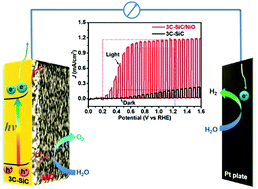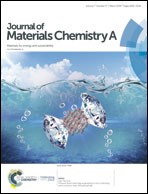A nanostructured NiO/cubic SiC p–n heterojunction photoanode for enhanced solar water splitting†
Abstract
Photoelectrochemical (PEC) water-splitting offers a promising method to convert the intermittent solar energy into renewable and storable chemical energy. However, the most studied semiconductors generally exhibit a poor PEC performance including low photocurrent, small photovoltage, and/or large onset potential. In this work, we demonstrate a significant enhancement of photovoltage and photocurrent together with a substantial decrease of onset potential by introducing electrocatalytic and p-type NiO nanoclusters on an n-type cubic silicon carbide (3C-SiC) photoanode. Under AM1.5G 100 mW cm−2 illumination, the NiO-coated 3C-SiC photoanode exhibits a photocurrent density of 1.01 mA cm−2 at 0.55 V versus reversible hydrogen electrode (VRHE), a very low onset potential of 0.20 VRHE and a high fill factor of 57% for PEC water splitting. Moreover, the 3C-SiC/NiO photoanode shows a high photovoltage of 1.0 V, which is the highest value among reported photovoltages. The faradaic efficiency measurements demonstrate that NiO also protects the 3C-SiC surface against photo-corrosion. The impedance measurements evidence that the 3C-SiC/NiO photoanode facilitates the charge transfer for water oxidation. The valence-band position measurements confirm the formation of the 3C-SiC/NiO p–n heterojunction, which promotes the separation of the photogenerated carriers and reduces carrier recombination, thus resulting in enhanced solar water-splitting.



 Please wait while we load your content...
Please wait while we load your content...